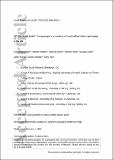Files in this item
“It's like sludge green” : young people’s perceptions of standardised tobacco packaging in the UK
Item metadata
| dc.contributor.author | MacGregor, Andy | |
| dc.contributor.author | Delaney, Hannah | |
| dc.contributor.author | Amos, Amanda | |
| dc.contributor.author | Stead, Martine | |
| dc.contributor.author | Eadie, Douglas | |
| dc.contributor.author | Pearce, Jamie | |
| dc.contributor.author | Ozakinci, Gozde | |
| dc.contributor.author | Haw, Sally | |
| dc.date.accessioned | 2021-03-11T00:39:06Z | |
| dc.date.available | 2021-03-11T00:39:06Z | |
| dc.date.issued | 2020-03-11 | |
| dc.identifier | 266125145 | |
| dc.identifier | ec678583-ce37-4f91-8c61-208136cb054c | |
| dc.identifier | 85081314945 | |
| dc.identifier | 000558086500016 | |
| dc.identifier.citation | MacGregor , A , Delaney , H , Amos , A , Stead , M , Eadie , D , Pearce , J , Ozakinci , G & Haw , S 2020 , ' “It's like sludge green” : young people’s perceptions of standardised tobacco packaging in the UK ' , Addiction , vol. Early View . https://doi.org/10.1111/add.14999 | en |
| dc.identifier.issn | 1360-0443 | |
| dc.identifier.other | ORCID: /0000-0001-5869-3274/work/70919887 | |
| dc.identifier.uri | https://hdl.handle.net/10023/21599 | |
| dc.description | Funding: This project was funded by the UK National Institute for Health Research (NIHR) PHR project 10/3000/07. | en |
| dc.description.abstract | Background and Aims Standardized tobacco packaging was introduced in the United Kingdom in May 2016, together with larger graphic warnings. This study explored young Scottish people's awareness of and perceptions about standardized tobacco packaging in the United Kingdom. Design Qualitative study using 16 focus groups conducted February-March 2017. Setting Four schools in Scotland based in areas of differing socio‐economic status (high versus medium/low) and two levels of urbanity (large urban versus small town/other urban). Participants Eighty‐two S2 (13–14 years) and S4 (15–16 years) students who were smokers or at‐risk non‐smokers. Measurements Focus groups explored perceptions of standardized packaging and health warnings. The qualitative data underwent thematic analysis. Findings Views about standardized packaging were generally negative. Packs were described as being unattractive, drab and less appealing than non‐standardized versions. The new health warnings generated negative affective, often aversive, responses. These varied depending on the image's perceived ‘gruesomeness’ and authenticity. Most participants thought that the impact would be greatest on young non/occasional smokers. There were divergent views about whether established smokers would be affected. Conclusions The introduction of standardized tobacco packaging and new larger graphic health warnings in the United Kingdom seems have reduced the perceived attractiveness of cigarette packs among young people in the United Kingdom who smoke or are at elevated risk of becoming smokers, disrupting positive brand imagery (the brand heuristic), increasing the salience of health warnings and contributing to denormalizing smoking. | |
| dc.format.extent | 9 | |
| dc.format.extent | 1181731 | |
| dc.language.iso | eng | |
| dc.relation.ispartof | Addiction | en |
| dc.subject | Adolescents | en |
| dc.subject | Cigarette | en |
| dc.subject | Health warnings | en |
| dc.subject | Packaging | en |
| dc.subject | Qualitative | en |
| dc.subject | Tobacco | en |
| dc.subject | RJ101 Child Health. Child health services | en |
| dc.subject | E-NDAS | en |
| dc.subject.lcc | RJ101 | en |
| dc.title | “It's like sludge green” : young people’s perceptions of standardised tobacco packaging in the UK | en |
| dc.type | Journal article | en |
| dc.contributor.institution | University of St Andrews. Population and Behavioural Science Division | en |
| dc.contributor.institution | University of St Andrews. Health Psychology | en |
| dc.contributor.institution | University of St Andrews. St Andrews Sustainability Institute | en |
| dc.contributor.institution | University of St Andrews. School of Medicine | en |
| dc.identifier.doi | https://doi.org/10.1111/add.14999 | |
| dc.description.status | Peer reviewed | en |
| dc.date.embargoedUntil | 2021-03-11 |
This item appears in the following Collection(s)
Items in the St Andrews Research Repository are protected by copyright, with all rights reserved, unless otherwise indicated.

